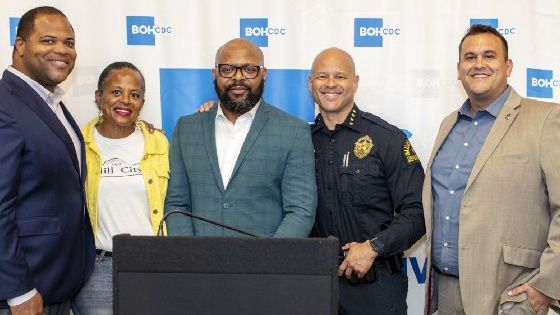DALLAS — Mayor Eric Johnson has announced a $100,000 grant to go toward South Dallas to fight against blight and lawlessness in the predominantly Black-neighborhood.
“Public safety is our top priority, but it is not solely the responsibility of law enforcement,” Johnson said. “To achieve our goal of becoming the safest major city in the United States, we need the assistance of community-based efforts such as this one. Blight remediation is a proven strategy for crime reduction and I firmly believe this investment in a strong — but historically underserved and overlooked — community will pay dividends for our entire city.”
The Safe Communities Fund — a private philanthropic fund created by Mayor Johnson — awarded $100,000 to the Builders of Hope — an affordable housing developer — to support a new public initiative in the Mill City area of South Dallas. Data shows that 5,000 households make up Mill City’s neighborhood. According to the Dallas Police Department, stats show that the community has seen 439 thefts offenses, 435 property destruction offenses, 281 burglaries, 182 cases of motor vehicle theft, 114 robberies and more than 550 assaults since 2017.
With the funds from the grant, Builders of Hope hopes to address four goals:
- Reduce the risk of violent crimes from occurring in the community
- Reduce the amount of crime that occurs in the community over the course of the initiative
- Increase resident satisfaction with the quality and condition of their neighborhood
- Provide an efficient alternative to current 311/Code Compliance model for addressing blight
“I am grateful to Builders of Hope for leading this project and I hope we can replicate it in other parts of our city as we continue to strive to build safer communities,” he said.
According to Builders of Hope, the success of the project will draw from three methods including process evaluation, field observation and condition analysis and lastly, method assessments:
- The process evaluation will assess whether the pilot is implemented as intended and identify distinct project elements that facilitate or hinder successful implementation. This evaluation will reveal specific strategies to replicate when expanding the pilot to a full-fledged program.
- While the physical evidence of this project will be clear within the community, a field observation protocol will be developed to document and assess conditions before, during, and after the remediation and maintenance efforts have been completed across the community.
- Quasi-experiments demonstrate causality between intervention efforts and related effects when randomization is not feasible. The initiative will employ quasi-experimental methodology to evaluate the impact of block-by-block remediation on outcome metrics, such as violent gun crime, over time.
In Philadelphia, a similar community initiative resulted in a 29% reduction in gun violence, a 22% decrease in burglaries and 30% drop in nuisances like noise complaints and illegal dumping in neighborhoods where vacant lots were cleaned up and blight removed.
The process of removing vacant lots and abandoned structures in Mill City will come from Builders of Hope’s project team with the help of neighborhood focus group. Additionally, the group plans to use risk-terrain remodeling to determine environmental facts that “contribute to the risk of gun-violence.” The team’s approach of a “block-by-block strategy” will not only reduce the wait time for an intervention, but also aid in prioritizing remediating every overgrown vacant lot as well as abandoned buildings.
“Like housing, public safety is a cornerstone of a healthy, thriving neighborhood,” Armstrong said. “And the more we can invest in non-enforcement solutions, the quicker we’ll see movement on improved public safety.”



